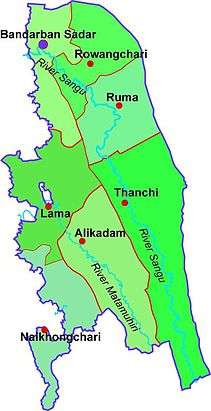Mru language
| Mru | |
|---|---|
| Mro, Maru, Mrung, Murung[1] | |
| Region | Bangladesh, Burma |
Native speakers | 50,000 (1999–2007)[1] |
| Mru alphabet, Latin alphabet | |
| Language codes | |
| ISO 639-3 |
mro |
| Glottolog |
mruu1242[3] |

Mru is a Sino-Tibetan language and one of the recognized languages of Bangladesh. It is spoken by a community of Mros (Mru) inhabiting the Chittagong Hill Tracts of Bangladesh with a population of 22,000 according to the 1991 census, and in Burma. The Mros are the second-largest tribal group in Bandarban District of the Chittagong Hill Tracts. A small group of Mros also live in Rangamati Hill District.
The Mru language is considered "definitely endangered" by UNESCO in June 2010.[4]
It is one of the Sino-Tibetan languages that are difficult to classify and has marginal affiliations with Burmic. Mru and Meithei in India, Bangladesh, and Burma, would appear close to the Kukish languages.[5] However, although once classified as Kukish, the Mru language is thought to be closer to Lolo-Burmese.[6]
Distribution

The Mros live in forest areas of Lama, Ruma, Alikaram, and Thanchi near Chimbuk Mountain of Bandarban District (Rashel 2009). They also live in Sittwe (Akiab), Rakhine State, Burma.
Subdivisions
There are five major Mro clans (Rashel 2009).
- Dengua
- Premsang
- Kongloi
- Maizer
- Ganaroo Gnar
Rashel (2009) also lists another classification scheme which lists ten Mro clans.
- Yarua (subdivisions below)
- Khatpo
- Chimlung
- Zongnow
- Chawla
- Yaringcha
- Tang
- Deng
- Kough
- Tam-tu-chah
- Kanbak
- Prenju
- Naichah
- Yomore
Numerals
Rashel (2009:159) lists the following Mro numerals.
- lɔk
- pre
- ʃum
- taːli
- taŋa
- tro
- rinit
- rijat
- tako
- muit
Alphabet
| Mru Mro, Krama[1] | |
|---|---|
| Type |
alphabet
|
| Languages | Mru |
| Direction | Left-to-right |
| ISO 15924 |
Mroo, 264 |
Unicode alias | Mro |
| U+16A40–U+16A6F | |
The Mru alphabet is an indigenous, messianic script: In the 1980s Menlay Murang (also known as Manley Mro) created the religion of Khrama (or Crama) and with it a new alphabet for the Mru language.[7][8]
The Mru (or Mro) alphabet is written from left to right and has its own set of digits. It does not use tone marks.
The Mru language is written using both the Latin and Mru alphabets.
Unicode
The Mru alphabet was added to the Unicode Standard in June, 2014 with the release of version 7.0.
The Unicode block for the Mru alphabet, called Mro, is U+16A40–U+16A6F:
| Mro[1][2] Official Unicode Consortium code chart (PDF) | ||||||||||||||||
| 0 | 1 | 2 | 3 | 4 | 5 | 6 | 7 | 8 | 9 | A | B | C | D | E | F | |
| U+16A4x | 𖩀 | 𖩁 | 𖩂 | 𖩃 | 𖩄 | 𖩅 | 𖩆 | 𖩇 | 𖩈 | 𖩉 | 𖩊 | 𖩋 | 𖩌 | 𖩍 | 𖩎 | 𖩏 |
| U+16A5x | 𖩐 | 𖩑 | 𖩒 | 𖩓 | 𖩔 | 𖩕 | 𖩖 | 𖩗 | 𖩘 | 𖩙 | 𖩚 | 𖩛 | 𖩜 | 𖩝 | 𖩞 | |
| U+16A6x | 𖩠 | 𖩡 | 𖩢 | 𖩣 | 𖩤 | 𖩥 | 𖩦 | 𖩧 | 𖩨 | 𖩩 | 𖩮 | 𖩯 | ||||
| Notes | ||||||||||||||||
References
- 1 2 3 Mru at Ethnologue (18th ed., 2015)
- ↑ Hammarström, Harald; Forkel, Robert; Haspelmath, Martin; Bank, Sebastian, eds. (2016). "Mruic". Glottolog 2.7. Jena: Max Planck Institute for the Science of Human History.
- ↑ Hammarström, Harald; Forkel, Robert; Haspelmath, Martin; Bank, Sebastian, eds. (2016). "Mru". Glottolog 2.7. Jena: Max Planck Institute for the Science of Human History.
- ↑ UNESCO, "Bangladesh: Some endangered languages (information from Ethnologue, UNESCO)", June 2010.
- ↑ Encyclopædia Britannica, Article: Sino-Tibetan Languages
- ↑ Peiros, Ilia. 1997. "Lolo–Burmese linguistic archaeology." Mon–Khmer Studies 27: 233–248. (Mon–Khmer Studies Journal website)
- ↑ Hosken, Martin; Everson, Michael (24 March 2009). "N3589R: Proposal for encoding the Mro script in the SMP of the UCS" (PDF). Retrieved 2 August 2014.
- ↑ Zaman, Mustafa (24 February 2006). "Mother Tongue at Stake". Star Weekend Magazine. The Daily Star. 5 (83).
- Peterson, David A., "Where does Mru fit into Tibeto-Burman?", The 42nd International Conference on Sino-Tibetan Languages and Linguistics (ICSTLL 42), November 2009, Payap University, Chiangmai, Thailand. Cf. p. 14.
- Rashel, Md Mostafa (2009). "Morphosyntactic Analysis of Mro Language." Dhaka University Journal of Linguistics, Vol, 2, No, 3, February 2009, 141–160.
Further reading
- Clifton, John M. 2009. "Orthography development as an ongoing collaborative process: lessons from Bangladesh". 1st International Conference on Language Documentation and Conservation (ICLDC)
- Mru word list (Luce 1985)
- Mru word list (Matisoff 1987)